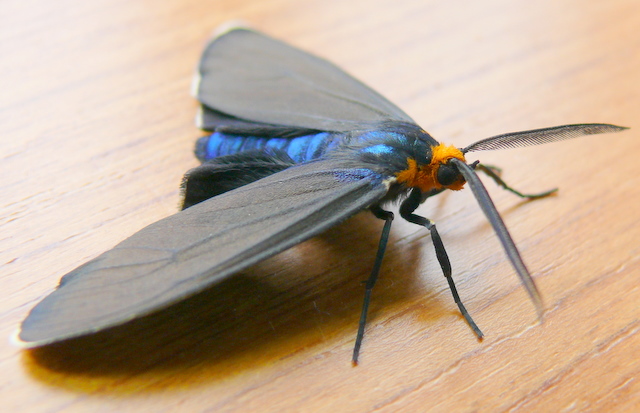Virginia, a state renowned for its diverse ecosystems, is home to a captivating array of flora and fauna. Among this multitude is an unassuming yet fascinating insect: the Virginia Ctenucha moth, or Ctenucha virginica. This moth is not just another winged creature; it encapsulates a myriad of ecological roles and aesthetic splendor, illuminating the rich tapestry of biodiversity in its native habitats. Today, we delve deeper into the world of the Virginia Ctenucha moth, presenting a more nuanced perspective on its importance and characteristics.
The Ctenucha virginica is often celebrated for its exquisite appearance, displaying iridescent hues that fluctuate between azure and emerald, depending on the light’s angle. This coloration is not merely for visual appeal; it serves pivotal functions in its lifecycle and survival. Mimicry and warning coloration are common strategies employed by many moths, allowing them to evade predators. Observing the vibrant colors of the Virginia Ctenucha can lead one to marvel at the intricate dance of evolution and adaptation that has sculpted its existence.
Yet, beauty aside, the Ctenucha virginica plays an integral role in its ecosystem. As a diurnal moth, it is active during the day, setting it apart from its nocturnal cousins. This active period allows for more substantial interactions with various plant species, serving as a pollinator for blossoms during the day. The symbiotic relationship between moths and plants is often underappreciated; however, the pollination activities of the Ctenucha moth contribute significantly to the proliferation of several native wildflowers. Such interactions highlight the often-overlooked interdependence of species, showcasing that even the smallest among us can have a monumental impact on their environment.
In terms of habitat, the Virginia Ctenucha is typically found in open fields, meadows, and transitional zones where the growth of grasses and wildflowers is abundant. These areas provide not only sustenance in the form of nectar but also suitable sites for laying eggs. Notably, the larvae have a specific dietary requirement, primarily feeding on the foliage of various grasses, which can position them as pivotal players in the dynamic of plant populations in their natives’ landscapes.
The lifecycle of the Ctenucha virginica is equally mesmerizing. Emerging from the egg stage, the larvae, or caterpillars, undergo several molts, each stage referred to as an instar. During this period, which can span weeks, they engorge on plant matter, storing energy for the metamorphosis ahead. Once fully matured, they spin a silken cocoon, entering a pupal stage that heralds their transformation into adult moths. This fascinating process is a salient reminder of nature’s capacity for change and resilience, as these moths can emerge from their cocoons, often in the company of others, creating spectacle in the air as they take their first flight.
The Virginia Ctenucha moth also serves as an indicator species, reflecting the broader health of its environment. Changes in its population dynamics can signal shifts in ecosystem stability, demonstrating how interconnected life is within its habitat. Consequently, researchers and ecologists monitor their prevalence and distribution, employing this data as a bellwether for assessing ecological changes. Understanding the locale and life cycle of this moth provides deeper insights into the delicate balance of their ecosystems.
Yet, despite its ecological significance, the Virginia Ctenucha moth and its habitats are not impervious to the encroachments of urbanization and environmental degradation. Developmental pressures and the use of chemical pesticides pose threats not only to the moths themselves but also to the intricate web of life they help sustain. Protecting these environments requires conscientious efforts, ranging from conservation initiatives to public awareness campaigns, underscoring the importance of safeguarding such unsuspecting but integral species.
Friends of the environment often turn to moths as symbols of understated beauty. As night falls, many people might be drawn to the enchanting dance of nocturnal moths, yet the Virginia Ctenucha, with its diurnal charm, plays an equally significant role in enchanting us. Overlooked in the quest for grandeur, this humble moth exemplifies the quiet yet profound impact of lesser-known species upon the natural world. Its vibrancy and ecosystem contribution reveal the intricate connectivity among life forms, emphasizing that every creature holds value in the grand scheme of life.
In awareness and appreciation of such marvelous insects, we realize that even the tiniest entities harbor stories worth telling. The Virginia Ctenucha moth doesn’t merely flutter across fields; it represents resilience, adaptability, and the critical balance of nature. As stewards of the Earth, comprehending the nuances of these relationships leads to a more conscientious approach towards preserving our shared environment. Acknowledging the splendor of the Virginia Ctenucha moth serves as a clarion call to protect the delicate web of life that flourishes in our backyards and beyond.









Leave a Comment